How To Win Friends and Influence Districts
From Ballot Lines to Battle Lines
This is a guest post by Sahaj.
With the 2026 midterms shaping up as a potentially decisive battle for House control, both parties are scrambling for marginal advantages wherever they can find them. When political margins are this tight, grabbing a few extra districts or moving a handful from competitive to safe can be worth more than most national advertising campaigns. Enter California's latest contribution to this arms race.
Revenge Geometry
Gavin Newsom announced last week that California would pursue constitutional changes allowing the state to redraw its congressional maps. The move comes in direct response to Republican redistricting shenanigans: specifically, Texas’ brazen attempt to gerrymander their way to a more comfortable House majority. The aptly named "Election Rigging Response Act" (a name that wins points for directness, if not subtlety) represents Newsom's latest salvo in what's shaping up to be a fascinating game of constitutional chicken between blue and red states.
“California will not sit idle as Trump and his Republican lapdogs shred our country’s democracy before our very eyes. In just six months, Trump’s unchecked power has cost Americans billions and taken an ax to the greatest democracy we’ve ever known. This moment calls for urgency and action – that is what we are putting before voters this November, a chance to fight back against his anti-American ways.”
It's not entirely without precedent: Pennsylvania Democrats attempted something similar in 2021, and North Carolina has been redrawing maps so frequently that mapmakers probably have the state’s districts memorised by now. But California's proposal represents the first systematic attempt to institutionalise redistricting retaliation.
Newsom’s recent actions, some may argue, are exactly what the democratic party has needed. Polling has consistently shown that democratic voters are not satisfied with their leaders and their constant rolling over for Trump. This, in turn, has led the Democratic populace to long for strong leadership to counter Trump. And so far, it looks like it's working.
Priced In
Newsom's 2028 Democratic primary odds have been quietly climbing, with various sources now placing him between 15-30% to win the nomination, up from single digits earlier this year. The redistricting announcement appears to have given him another bump, suggesting that markets view his willingness to fight constitutional hardball as a feature, not a bug.
Of course, Newsom still faces the fundamental challenge that has dogged California politicians in national races: the state's brand problem. California remains deeply unpopular in swing states, associated with progressive overreach, tech elitism, and cultural liberalism that plays poorly outside major metropolitan areas. The last California Democrat to win the presidency was... well, there isn't one.
Newsom appears to understand this liability, which may explain his recent positioning moves. The redistricting fight allows him to demonstrate toughness, while his bipartisan moments with Trump show he can work across the aisle when necessary. It's a calculated attempt to build a more complex political profile that transcends the typical "California liberal" caricature, though whether swing voters will buy it remains an open question that prediction markets are still pricing.
After years of watching Republicans systematically dismantle norms while Democrats held increasingly ineffective seminars on institutional integrity, Newsom’s approach feels refreshingly direct. The man who built his early career on progressive virtue signalling has apparently learned something about the modern political moment. Sometimes you need to meet fire with fire (or perhaps more accurately, fight all-caps Twitter tantrums with all-caps Twitter tantrums).
Borderline Behavior
The proposed redistricting would shift California’s delegation from 43-9 Democratic to roughly 48-4, targeting five current Republican seats held by Representatives Doug LaMalfa, Kevin Kiley, David Valadao, Ken Calvert, and Darrel Issa.
Aggressive map-drawing comes with real risks too, though: stretch districts too thin, and a wave election can turn carefully crafted gerrymanders into disasters.
But here's where the Democratic disadvantage becomes clear: Republican states are simply better positioned for redistricting shenanigans. Texas, Florida, and North Carolina can redraw maps with minimal Democratic input, while blue states like California, New York, and Illinois often constrain themselves with independent commissions or court oversight. It's a structural asymmetry that provides a fair bit of context to these recent Democrat actions. The stakes, as Newsom put it, “couldn't be higher,” and the maps reflect that urgency.
The broader strategic shift this represents shouldn’t be understated. For decades, Democrats have operated under the assumption that institutional norms would protect them from the worst excesses of partisan politics. The California redistricting proposal represents a formal (and timely) abandonment of that assumption in favor of something more pragmatic: if Republicans are going to weaponize every available tool, Democrats will need to do the same.
Symmetry Trouble
In Republican fashion, California Republicans have filed suit to block Newsom's redistricting proposal, which creates an amusing spectacle of the same party simultaneously defending Texas's right to redraw maps while challenging California's right to do the same. While they have yet to address the unmistakably awkward optics of the situation, the legal challenge of the state’s constitutional provisions may still prove noteworthy for the Democratic effort.
It’s also particularly interesting to see how prediction markets are parsing Newsom’s various moves. While his overall 2028 odds have climbed steadily, traders seem to be distinguishing between the different parts of his political evolution. His willingness to engage in partisan welfare reads as a positive general election viability, but markets remain split on whether this Californian brand can survive national scrutiny.
The redistricting fight offers a useful test case. If Californian voters approve the constitutional amendment by overwhelming margins, expect Newsom’s odds to continue climbing. If it struggles, markets may begin pricing in electoral resistance to his particular brand of strategic opportunism.
Additionally, Trump also announced Monday that the DOJ will sue California over its redistricting plan, while simultaneously celebrating Texas Republicans' similar effort to redraw their maps.
Trump indicated he'll be "filing a lawsuit pretty soon" against Newsom's redistricting efforts, though the legal basis remains unclear. Federal courts have historically been reluctant to intervene in state redistricting processes, and the Supreme Court has largely removed itself from partisan gerrymandering disputes.
Whether this actually deters anyone remains to be seen (and it may as well end up boosting Newsom’s anti-Trump showdown).
Californian Succession
But redistricting isn't the only California political story generating market interest. Kamala Harris's decision last month not to run for governor in 2026 has created a fascinating succession puzzle that could influence Newsom's own political calculations. Harris had been leading early polling for the race, and her withdrawal has left "a crowded field of Democrats with no clear front-runner."
Current polling shows former Orange County Rep. Katie Porter leading the Democratic side, but the race remains wide open. This presents Newsom with an interesting dilemma: does he endorse a successor who might build on his political legacy, or does he stay neutral to avoid alienating potential allies for his own 2028 run?
The popular consensus seems to be on neutrality, at least publicly. Any endorsement risks creating enemies among the losing candidates, and Newsom needs to maintain relationships across the California Democratic establishment for his presidential ambitions. But his behind-the-scenes preferences will inevitably leak, and markets will be watching for signals about which direction he's leaning.
Happy Forecasting!
-Above The Fold


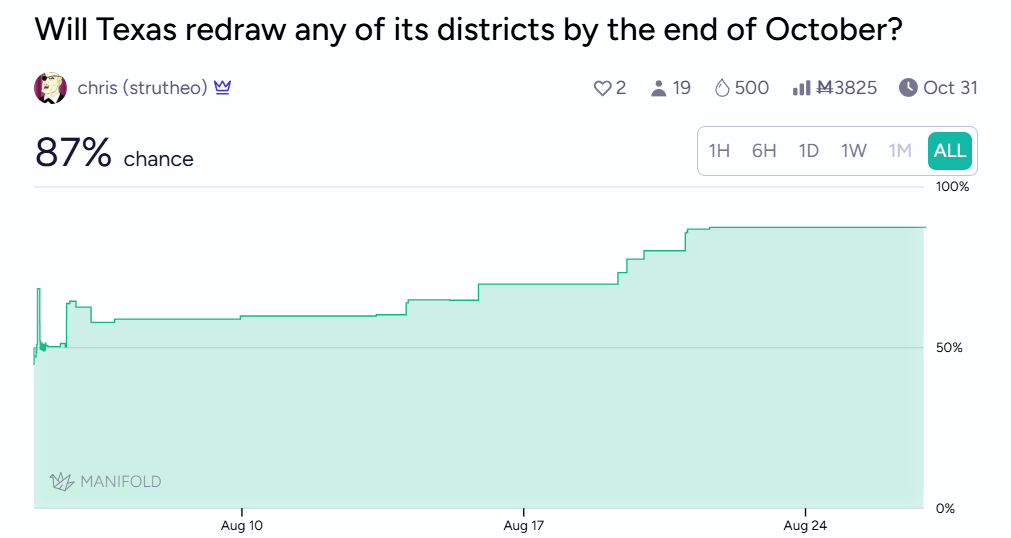
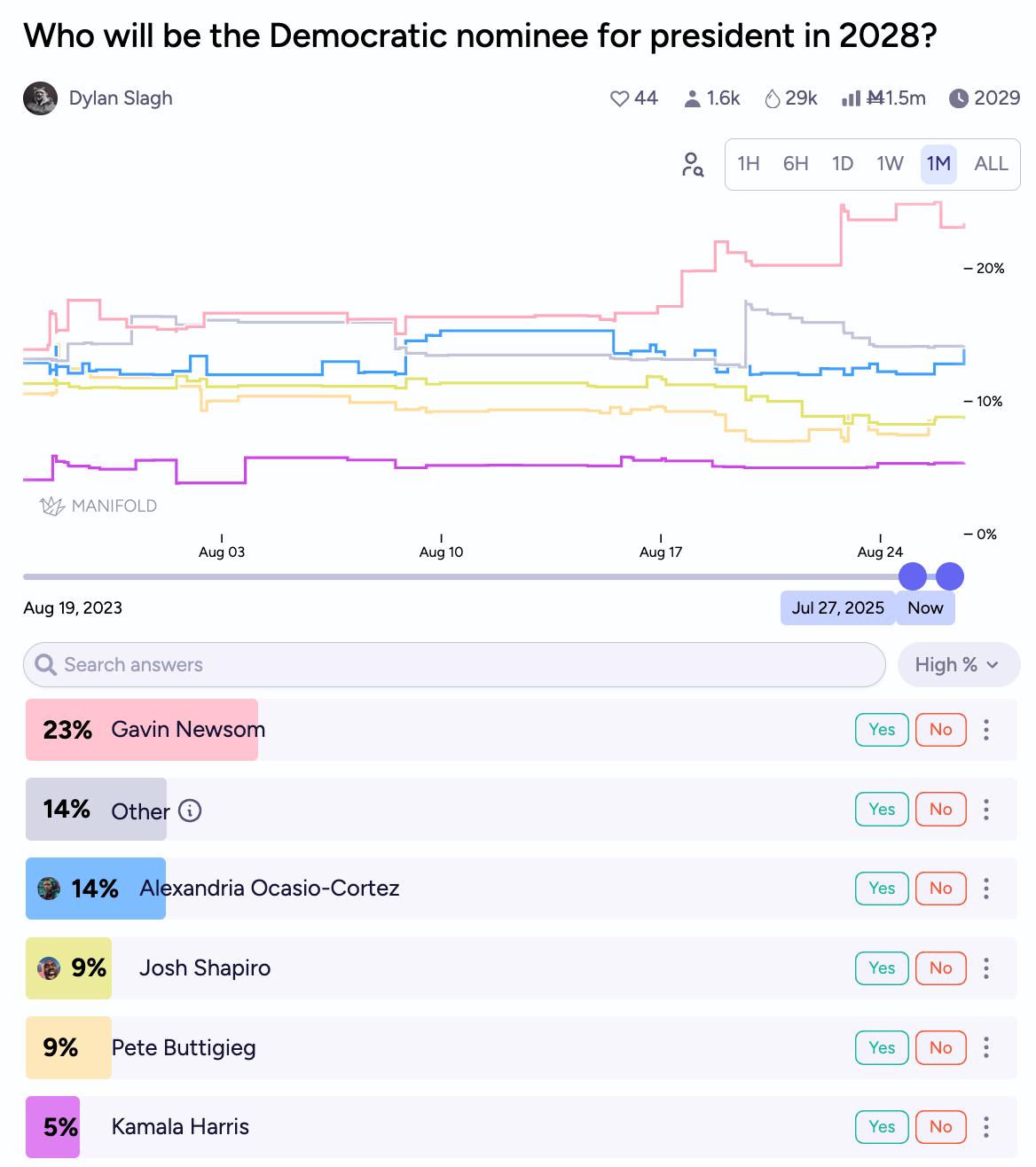
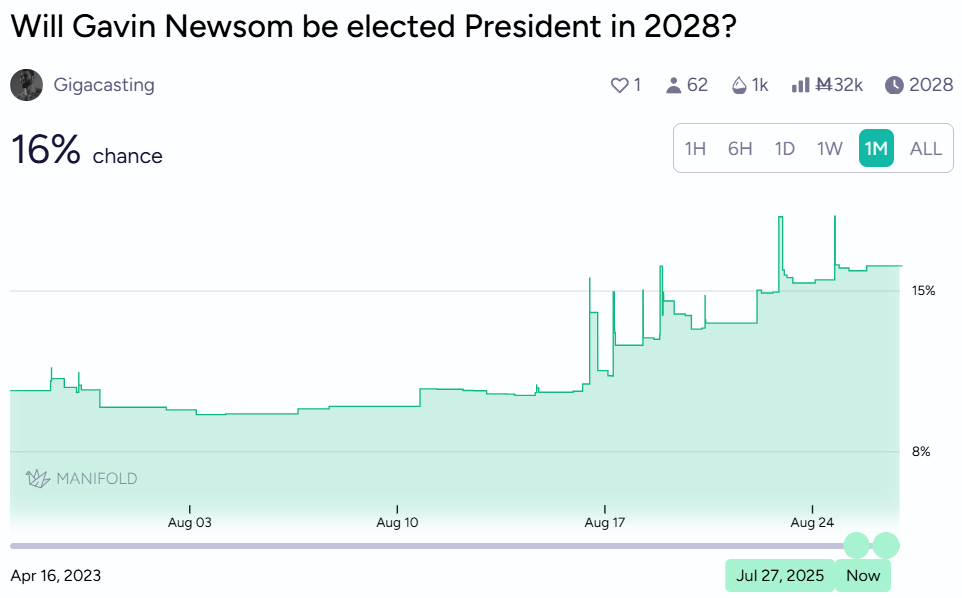
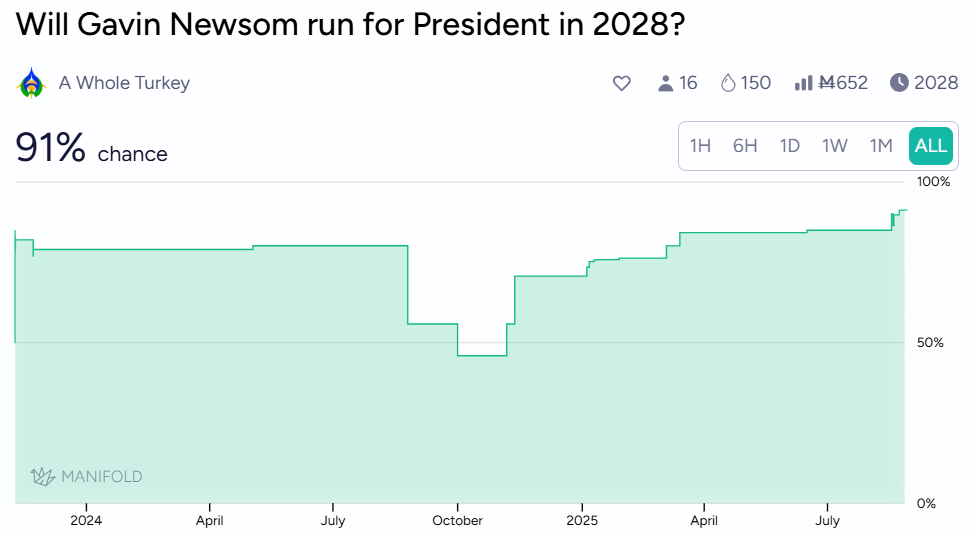
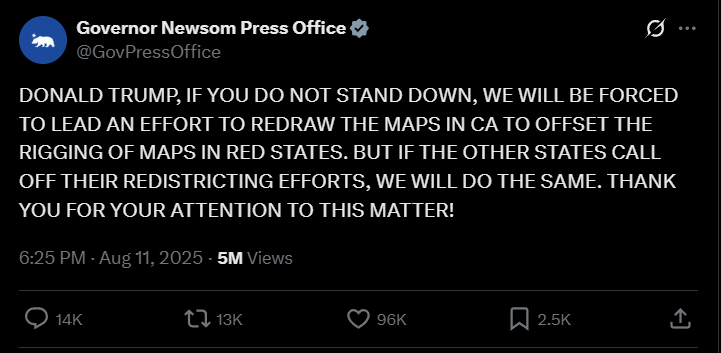
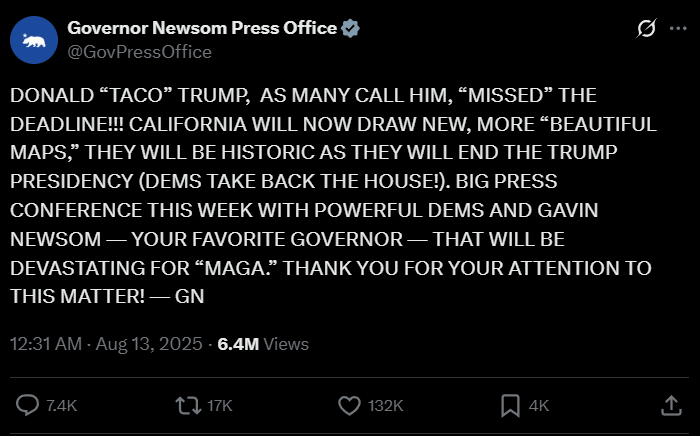
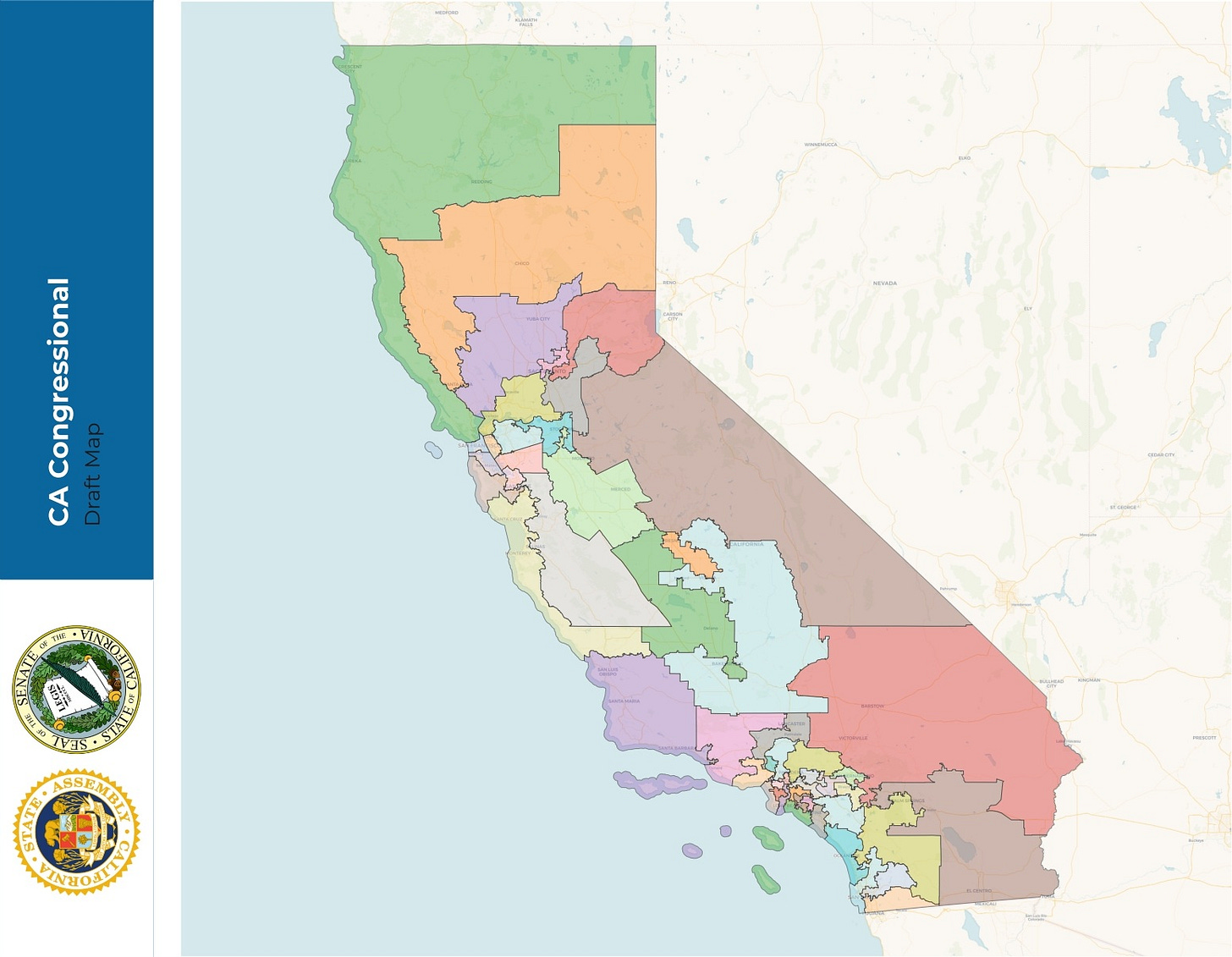
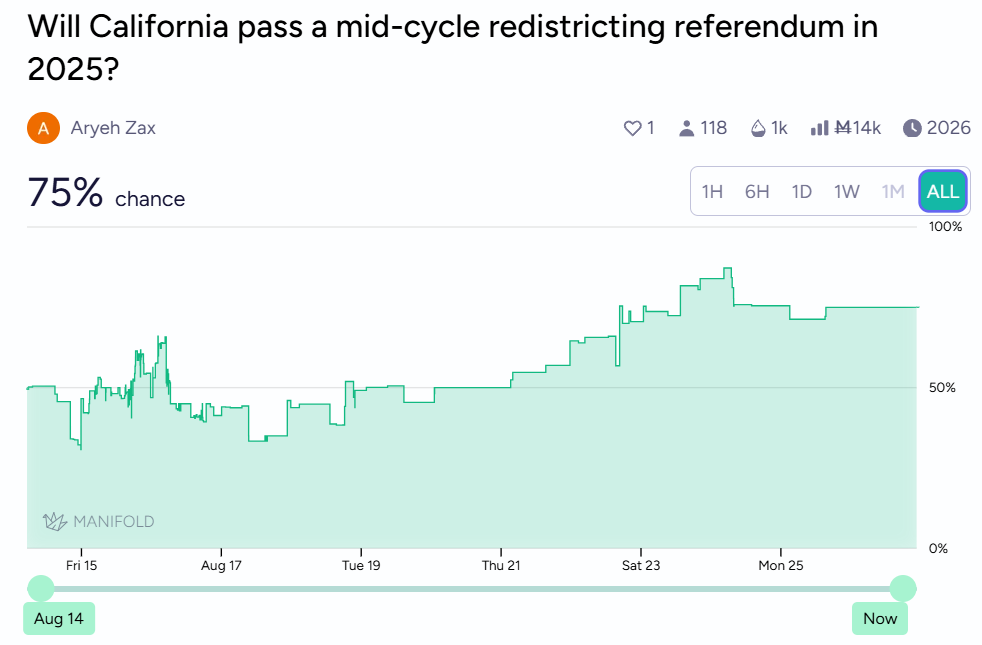
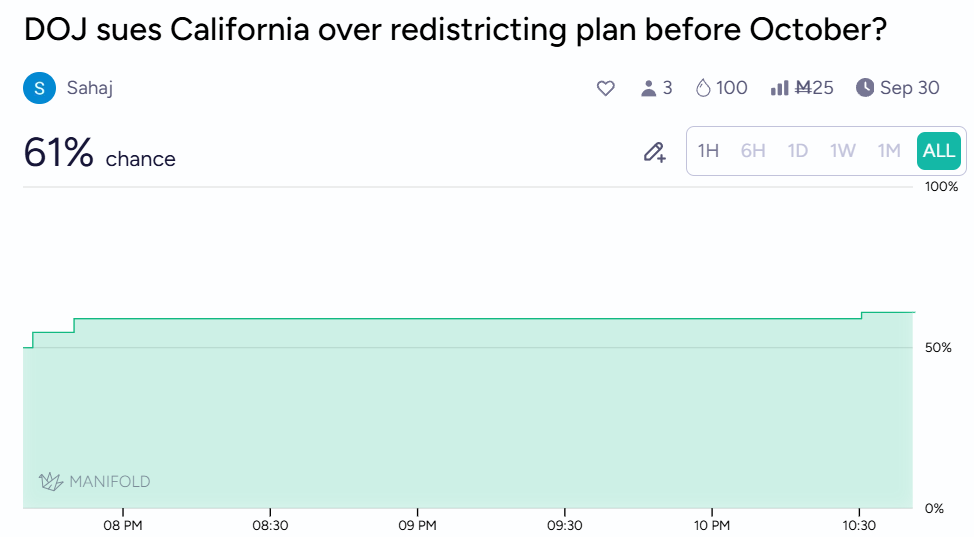
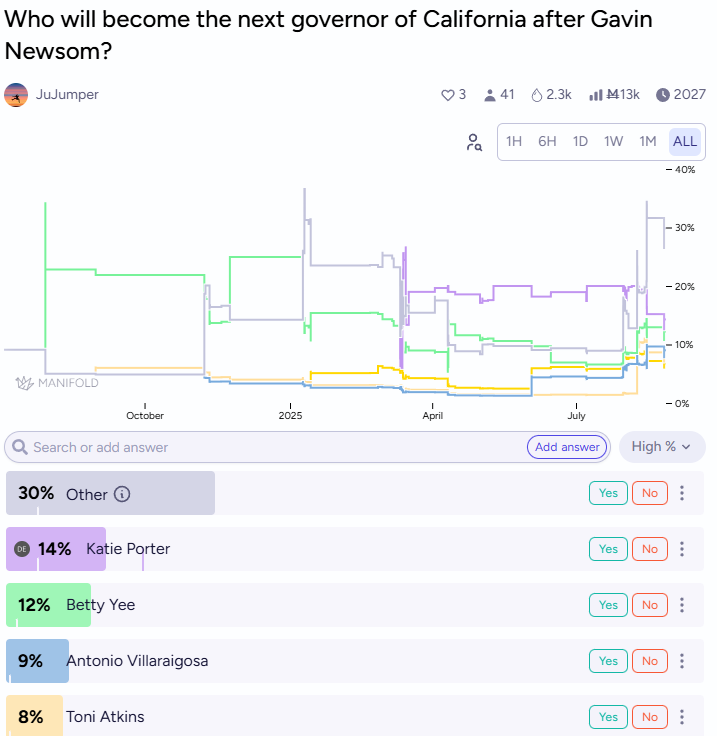
I made a market to ask whether the redistricting will happen and if it does what the chances of various outcomes from it will be - I think it's useful to think through what the electoral advantage would be here.
https://manifold.markets/BoltonBailey/will-ca-redistrict-and-what-will-be